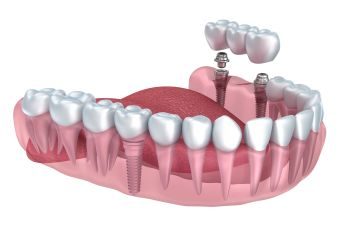
Everyone loves a beautiful, bright smile. When your smile is tarnished by the gaps left from tooth loss, it is time to consider all your options. Filling those gaps is not a difficult matter. Deciding the best way to fill them can be challenging, since there are many factors to take into account.
Know Your Options
The first step in making the decision on how best to close those gaps is to become familiar with all the options you have available. The number of teeth that are missing, location of the gaps and the length of time the teeth have been missing all play a role in your decision on how you want to replace those missing teeth. Bone health may also be an issue that impacts your decision.
Implants, Bridgework or Partial Dentures
You may have a few teeth missing in the same area and are looking at ways to restore them. Depending on the situation, you can choose from a bridge, dental implants or a removable partial denture. Each has its advantages and disadvantages. If your molars are missing in the upper or lower arch on one side, a traditional dental bridge may not be the answer, if there are not teeth on both sides of the gap on which to suspend a bridge. These abutment teeth are necessary in order to make a bridge work.
At the same time, you may want to consider a dental implant to act as an abutment tooth. A dental implant works as an anchor, so the artificial teeth can be suspended between it and the natural tooth. This allows you the advantages of having a dental bridge and eliminates the cost of getting several implants to restore each individual tooth.
A removable partial denture is also a good choice for replacing teeth when a dental bridge is not possible. The partial is just as it says – part of a denture that replaces missing teeth. The partial denture can replace missing teeth on one or both sides of the arch.
Traditional or Implant-Supported Dentures
When all the teeth on an arch are missing, you still have a few different options. Years ago, tooth replacement in this scenario was limited to traditional removable dentures. Now we live in an era where you have more than one choice.
Removable dentures are affordable, but they can also be inconvenient at times. Sometimes they can cause embarrassing moments that can be humiliating. On the other hand, some individuals have had their removable dentures for several years with no complaints.
Alternatives to traditional removable dentures use implants to support the dentures. Currently, there are two types of implant supported dentures, bar-retained dentures and ball-retained dentures. Both types hold your dentures securely in place.
Advantages and Disadvantages of Traditional Dentures
Traditional dentures replace teeth in form and function while being removable. These types of dentures can be full or partial, depending on how many teeth need to be replaced. Removable dentures are taken out for cleaning and you do not sleep with them in.
One of the main advantages of traditional dentures is cost. They are affordable for most patients. They can also look very natural and well-made, traditional dentures will serve you well for several years.
Your traditional dentures may need adjusting to begin with and throughout the time you have them. They are cast in acrylic and do not change as the geography of your mouth may change over the years. Sore spots may develop, and these will need to be removed from time to time. Your ridge may change with weight loss or age and your dentures may need a “reline.” This is a process by which the part of the denture that rests on the ridge is basically redone in order to accommodate changes.
Most often a reline is necessary when the dentures become loose and fail to fit comfortably. Loose dentures can be very irritating and embarrassing. Food particles can get caught between the gums and the dentures, making it impossible to eat until the particles are cleaned away. When you are out among friends, this usually means an abrupt trip to the washroom to rinse your mouth and dentures to get a comfortable fit again.
Loose dentures can also become dislodged when you are speaking, laughing or eating. Blowing out your birthday candles and losing your teeth at the same time may be funny or endearing to those watching, but you may feel embarrassed and humiliated. Eating hard or sticky foods may be difficult as well. Sticky foods in particular have a tendency to cause traditional dentures to become dislodged.
Adhesive pastes and creams are used to prevent disasters like this from happening, but their ability to hold dentures securely only lasts for so many hours. If you are planning on wearing your dentures throughout the day and into the night, you may need to be prepared to refresh your adhesive toward evening and perhaps more often, depending on the foods you eat.
Advantages and Disadvantages of Implant-Supported Dentures
One of the main advantages of implant-supported dentures is their stability. They are also easy to maintain. Implant-supported dentures may be able to restore some health benefits to your mouth in addition to giving you a very natural-looking smile. Because they are so durable and sturdy, you can eat all the foods you like without worrying about dislodging your dentures.
Implant-supported dentures are permanent and you care for them as you would your normal teeth. Brushing and flossing keep your implant-supported dentures clean. Regular checkups with your dentist are still important. Your dentist will need to examine your implants to identify any problems and make sure they remain healthy.
The drawbacks of implant-supported dentures come in the cost and the placement of the implants. Most dental insurance companies will not cover the cost of implant-supported dentures, or will only cover it partially. Additionally, the implant process is considered a surgical procedure and as such, is more expensive than that of traditional dentures.
The implant process is accomplished in stages. In the first stage, the implant – a titanium, screw-like pin – is set in the bone. The bone must fuse with the pins, creating a sturdy foundation. This process can take several weeks. Once the bone and pin have fused together, the next two stages of the implant process can go forward.
The bone surrounding the designated implant area must also be healthy and dense enough to support an implant. When this is not the case, a bone graft may be recommended. A bone graft is another surgical procedure in which a small piece of bone is grafted onto the jawbone at the implant site to strengthen existing bone.
Even though implant-supported dentures can be costly, those who choose this option are highly satisfied with the outcome. The peace of mind knowing your teeth will always be in place is enough for many who find themselves in the public spotlight often.
If you are considering replacing missing teeth, be sure to look at all available options. Give us a call at Aesthetic & Implant Dentistry of Atlanta and schedule a consultation appointment with us. We are happy to answer all your questions and explain in detail the implant process, whether you are a good candidate for the procedure, what you can expect and the pros and cons of both traditional and implant-supported dentures.
Your optimal oral health is our priority, and we want to help you achieve your best smile. Missing teeth need to be replaced in order to maintain a healthy mouth. Call today to schedule your appointment with us and learn the ways your missing teeth can be replaced.



